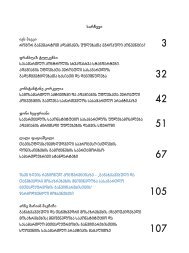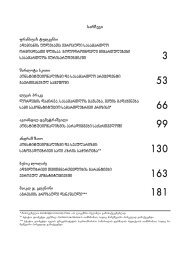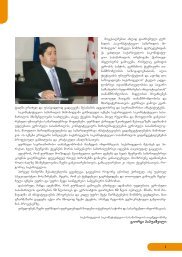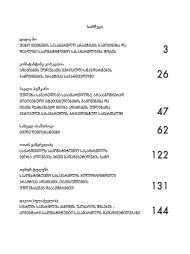Contents - Constitutional Court of Georgia
Contents - Constitutional Court of Georgia
Contents - Constitutional Court of Georgia
You also want an ePaper? Increase the reach of your titles
YUMPU automatically turns print PDFs into web optimized ePapers that Google loves.
76<br />
Lucas Prakke<br />
It is a measure which should be so emphatically rejected that its parallel will never again be<br />
presented to the free representatives <strong>of</strong> the free people <strong>of</strong> America. 65<br />
On 22 July 1937 the Senate concurred with this report by 70 votes to 20, which meant the end<br />
<strong>of</strong> the <strong>Court</strong>-packing plan. In the meantime, however, spectacular developments had taken place<br />
in the Supreme <strong>Court</strong>. First <strong>of</strong> all, there was the latest act <strong>of</strong> swing-man Roberts. When he became<br />
a member <strong>of</strong> the <strong>Court</strong> in 1930 he initially pursued a fairly liberal course. Little by little, however,<br />
the Four Horsemen managed to draw him over to their side, with disastrous consequences for the<br />
New Deal. The sharply rising tension between the President and Congress on the one hand and the<br />
<strong>Court</strong> on the other, and Roosevelt’s tremendous election victory in November 1936 must, however,<br />
have convinced Roberts that things could not go on this way. On 29 March, 12 April and 24 May<br />
1937 the Supreme <strong>Court</strong> gave rulings in three very important cases, in which it set aside earlier<br />
interpretations <strong>of</strong> the Constitution and decided in favour <strong>of</strong> the constitutionality <strong>of</strong> the laws at issue.<br />
66 In all three instances the decision was taken by five votes to four, and in all three instances it<br />
was swing-man Roberts who departed from his earlier view and clinched matters: ‘A switch in time<br />
saved the nine’ people joked. 67 This was not just a witty remark, it was also a revealing joke, as it<br />
presupposed that the Senate Judiciary Committee had only permitted itself the luxury <strong>of</strong> a principled<br />
and scathing judgment <strong>of</strong> the <strong>Court</strong>-packing proposal in the knowledge that the proposal was<br />
no longer necessary, because the Supreme <strong>Court</strong> – i.e., Justice Roberts – had already come down<br />
a peg or two anyway. FDR for his part was later to conclude with satisfaction: ‘I lost the battle, but<br />
I won the war’. 68 And the icing on the cake <strong>of</strong> that victory was the resignation <strong>of</strong> a battle-weary<br />
Horseman, the 78year-old Justice Van Devanter, on 2 June 1937. Roosevelt was able for the first<br />
time to appoint a member <strong>of</strong> the <strong>Court</strong>. He chose Hugo Lafayette Black, a man who in spite <strong>of</strong> the<br />
youthful lapse <strong>of</strong> briefly being a member <strong>of</strong> the Ku Klux Klan would for decades adorn the <strong>Court</strong> as<br />
a ‘liberal’ Justice. In the years that followed, President Roosevelt was to have the opportunity more<br />
than once to make his mark on the composition <strong>of</strong> the <strong>Court</strong> through new appointments, and hence<br />
on the developments in case-law. But the ‘constitutional revolution <strong>of</strong> 1937’ had in itself already<br />
been enough to clear the way for the New Deal.<br />
Following our stay in the New World, it is now time to return to the Old. Let’s go home – to<br />
Belgiu m.<br />
65 Dowling and Gunther, op. cit., p. 268; Rodell, op. cit., p. 250. The period from 5 Feb. 1937 (introduction <strong>of</strong> the <strong>Court</strong>-packing plan) to<br />
22 July 1937 (rejection by the full Senate) is described in Alsop and Catledge, The 168 Days, 1938.<br />
66 Jackson, op. cit., chapter VII: The <strong>Court</strong> Retreats to the Constitution; McCloskey, op. cit., p. 174 et seq.: The <strong>Constitutional</strong> Revolution <strong>of</strong><br />
1937; Rodell, op. cit., p. 248 et seq.<br />
67 A reference to the English proverb ‘A stitch in time saves nine’.<br />
68 Dowling and Gunther, op. cit., p. 268. Rodell, op. cit., chapter 7: The <strong>Court</strong> Collides with the New Deal and Wins the Battle by Defaulting<br />
the War.






